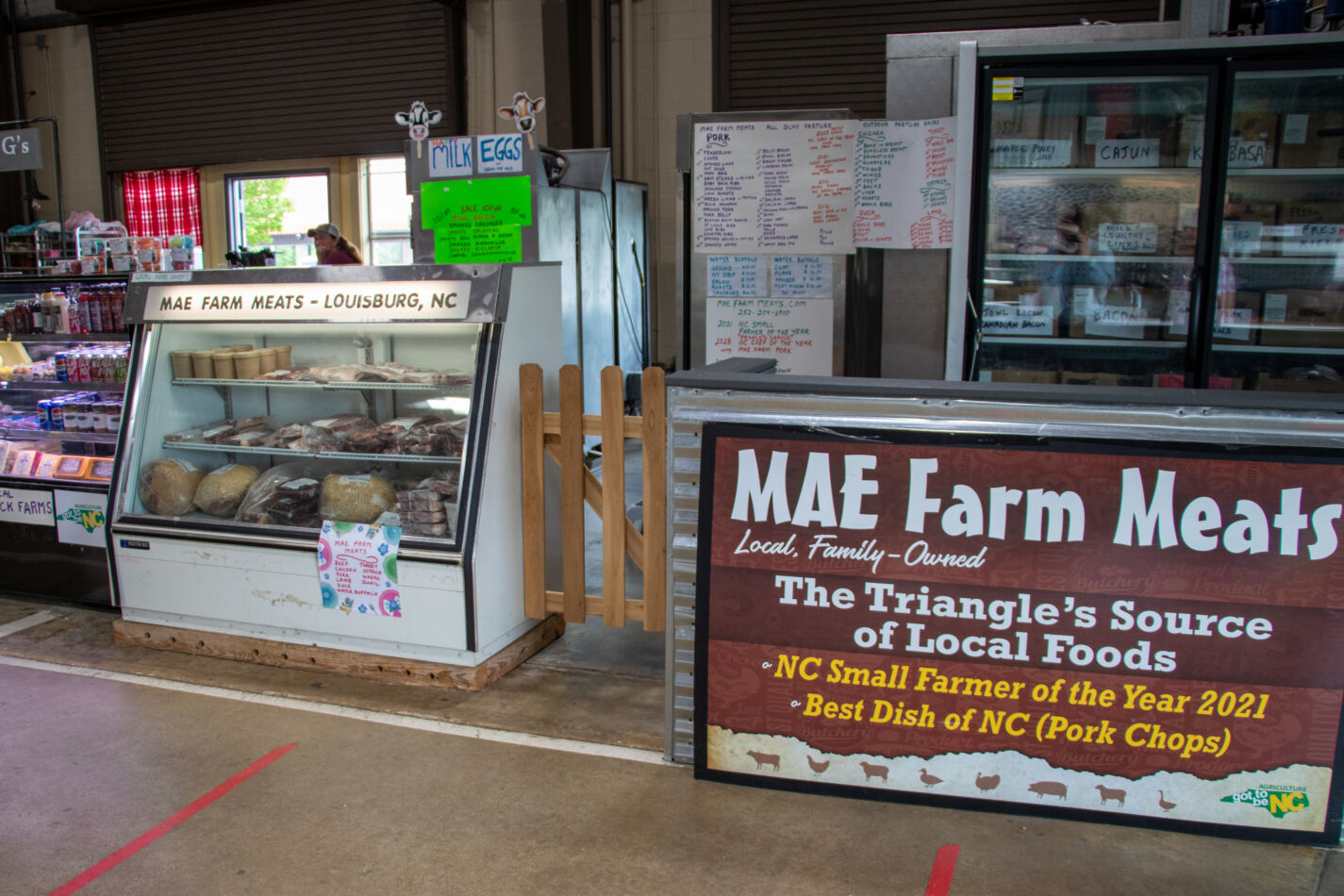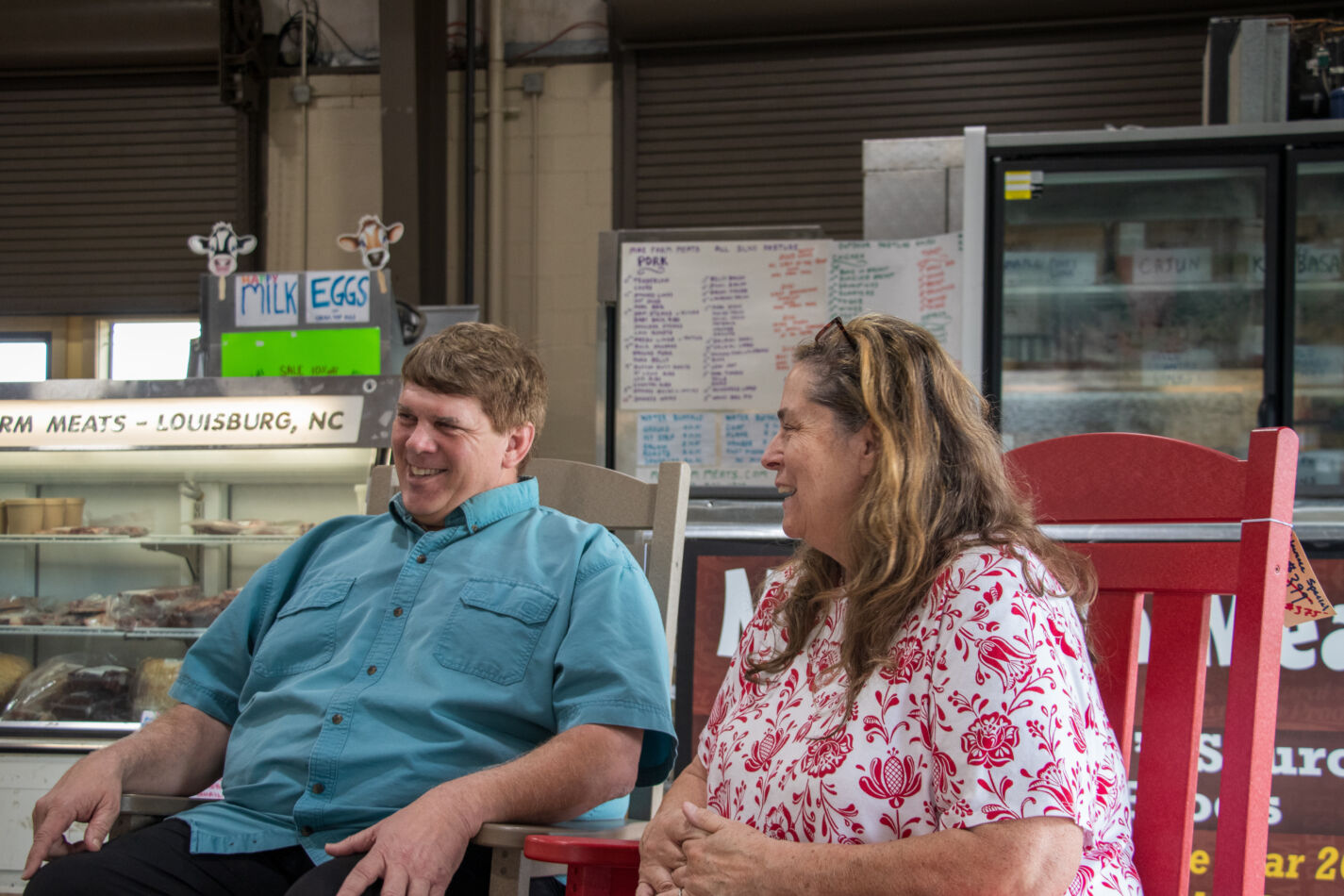Food deserts and food insecurity are part of society, not only here in North Carolina, but across the nation. These challenges often require complex solutions. However, it is only by directly addressing these issues, rather than cowering in fear, that we can strategize solutions to real problems that impact the lives of real people every day. We have spoken to real people with real stories; Mike Jones is the first of many to come.
As sticky inflation has continued, prices at the grocery stores have steadily increased, causing even more people to become food insecure. Unfortunately, economists predict that food prices won’t be going back down this year.
Mike Jones owns MAE Farm Meats, which he started in 2004 with his wife, Suzanne. “MAE” are the initials of Mike and Suzanne’s three children: Max, Audra, and Enya.
Mike is a farmer, and farmers are central to the agriculture industry, which is not only the No. 1 industry here in North Carolina, but is also a crucial part of addressing food insecurity and deserts. Agriculture is the foundation, and that is where we must start.
Mike spoke about how he has seen food deserts develop mainly in inner cities. This problem is primarily due to the need for more customer parking for such facilities and space. Trucks importing products need to be able to navigate the city, which is often difficult for them. Food deserts are also frequently found in rural areas, due to the need for high levels of customer traffic to justify opening such businesses.

“It has to have a certain amount, a certain volume of business to make it, because grocery-type businesses have low margin, so they have to move a lot of products,” Jones told the Carolina Journal. “It is a business that requires a lot of people. That’s why alot of a lot of food businesses do well in suburban areas because there’s enough room for a place and a parking area. People from the country can come to it, and people from the city can drive out to it. That’s why you’re seeing it is almost like a donut where you got all of these grocery stores, and then in the center, you don’t have any, and on the outskirts, don’t have any.”
Food insecurity is driven, in part, by the cultural preference for cheap food, Jones says, which frees up money for people to spend on travel and entertainment, and other priorities.
“So by trying to hold the price of food down for so long, what it did was it made only very efficient people be able to survive,” said Jones. “Which means you lose choice and eventually you lose resiliency and sustainability because as you shrink your food producer group down, they are moving a huge amount of food and they’re very efficient. But if something goes wrong, like in COVID, when we had supply chain disruptions, then people go to the grocery store and there’s nothing.”
Transportation has been one of the most challenging areas for a supply chain breakdown. If something happens that causes the resources to be diverted or delayed, it impacts the whole system because everything is interconnected. After all, commodities like food are globally based.
“We have inputs from all over the world coming into our country, and we’re also exporting things,” said Jones. “So sometimes, if you can’t export something, you can’t import. Because the ships that carry the stuff out, they’re not coming back if they don’t go out. So, that balance of trade has to continue to keep your commodities going, which are normally the raw materials used to produce fertilizers and soil amendments. In this country, those things are converted into grains and livestock production, to meat, milk, eggs[…]. Those agricultural products are shipped to other countries and, processed in the other countries, and then come back here. So anytime fuel prices are up, or shipping upset, or global tensions where people are fighting and things aren’t able to move around as well, or they’re delayed — that starts to cause a hiccup everywhere because we are very globally tied together.”
One of the most significant changes in agriculture from pre-COVID to post-COVID is people are more reluctant to take investment risks for fear of the world coming to a screeching halt again.
“I do see it weighing on people’s decisions about how much risk they’re willing to take,” Jones admitted. “And I think people will be willing to take more risk the further we get away from COVID, but I think right now a lot of people are just looking at saying, ‘I don’t know, if I stop if I borrow money or extend myself or invest in this and start going and then what’s going to happen if the government says I can’t be open for six months?’ So, I do think a lot of people still have some fear and uncertainty.”
Mike and Suzanne talked about how their business was affected during Covid, including some of the benefits of sourcing locally and having a sustainable business model.
“We benefited from COVID, because [before] we were having some difficulty because we weren’t getting enough volume of business,” said Jones. “But with COVID, when the grocery stores were empty, and we weren’t empty, then our existing customers became even more loyal, and then we got new customers, and some of those customers have dropped off now that it’s eased off, but it’s still positive progress, like the upswing that occurred for our business in COVID has held steady.”

Jones said that combatting food insecurity starts at with education and workforce development so people have a better understanding of how such economies work and how they can work better.
“The quick and easy answer is just to give you a SNAP program or a food stamp, but that’s the easy thing,” Jones said. “Just give people money, just to get through. The sustainable solution is to help those people earn enough money that they don’t have to have that, but that’s a lot harder to do. I think that we need to start at the university level, discussing human resources, how to treat everyone in your system well. How to engage them, how to get them to do their best, because so many people in the workplace today, they don’t do their best for the people they work for.”
Jones struck a critical component that is central to the heart of this project and the heart of food insecurity —a focus on people.
People are central to nearly every aspect of economic life, but especially this one. We highlight the Sowing Resilience project by focusing on the dad struggling to make ends meet, the single mom struggling to put food on the table, or the child who was abandoned to fend for themselves. With people, you have customers; with customers, you have business, and with business, you earn money.
“No matter what kind of business you have, you still have to focus on the people,” said Jones.
Jones said that if we don’t invest in people and don’t support people in agriculture, especially young farmers, we will see more synthetic foods in the next five to 10 years.
“If we don’t support more people being in agriculture, more individuals, more opportunities; if we don’t support people like myself, and help us continue to produce natural food; we’ll move to [cheaper quality foods],” lamented Jones. “I do think that if we don’t immediately start supporting people like my son Max, and other people his age that want to farm — a lot of people want to farm and just can’t break in — if we don’t invest in young people becoming farmers, having the access to do it, then we’ll move to large corporations producing synthetic food just because food is needed.”